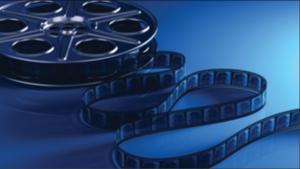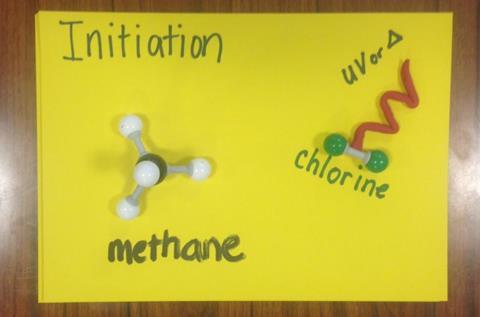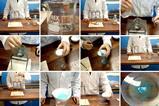Learning and understanding chemical concepts through a stop motion animation activity

Last month we hosted ChemEd Ireland at my institution. ChemEd is an annual gathering for chemistry teachers that provides an opportunity to share resources and ideas relevant to teaching chemistry and science. I was deputised to assist Maria Sheehan of the Professional Development Service for Teachers, who ran a workshop on using stop motion animations – animations made up from a series of individually constructed scenes.
Movie making
Maria’s concept was very simple. The activity required each group of 3–4 to explain a chemical concept using stop motion animation. This involved:
- Planning a storyboard containing five or six scenes that would be assembled to form the animation
- Constructing each scene using sketches, modelling clay, molecular models, or anything else suitable
- Taking photos of each scene with a digital camera or cameraphone
- Importing the photos into Windows Movie Maker (free software) and producing animation.
The various groups got to work on a range of topics: ionic bonding, chlorination of methane, and catalytic converters come to mind. But to watch the process in action was quite informative.
The process involves the group discussing the content and sequence of their animation. This means they need to talk out what is happening, what to choose to put in each scene, and why they put one scene before or after another. I was surprised and pleased to see this, but because most of the activity was around this discussion of chemistry involved. The technology – taking photos, importing to Windows Movie Maker, and producing – was quick and easy enough not to distract from the job at hand: explaining chemical concepts. In addition, judging by the level of noise from the audience, it looked like a lot of fun too. The bonus is that there is an output of a product, useful for revision, assessment or critique.

Maria explained that the activity is particularly useful for explaining organic chemistry reactions – the sequence of the making and breaking bonds lends itself well to stop-motion animation. I was certainly impressed with the group completing the chlorination of methane animation. But there doesn’t seem to be any limit to the application of this clever idea. I’m sure the misconception afficianados will be delighted to hear that the ionic bonding animators showed sequences where the ions were formed first before electrostatic attraction pulled them together.
Producing learning resources
While Maria’s workshop was meant primarily as a classroom activity, there’s no reason why it couldn’t be extended to produce reusable learning resources. The length of scenes of each photo within Windows Movie Maker are set to a default time (five seconds), but each scene can be varied as required. Text captions can be added easily, and the entire piece, once produced, is a Windows Media Video (wmv) file, which can be hosted on a virtual learning environment or uploaded to YouTube. It provides an interesting alternative to posters or presentations and I think the group element requiring students to discuss the chemistry of the concept is a real added value of this approach.
My thanks to Maria Sheehan for allowing me to reproduce the outline of her workshop here.














No comments yet